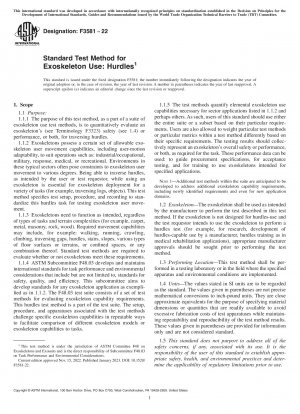ASTM F3581-22
Standard Test Method for Exoskeleton Use: Hurdles
- Standard No.
- ASTM F3581-22
- Release Date
- 2022
- Published By
- American Society for Testing and Materials (ASTM)
- Latest
- ASTM F3581-22
- Scope
- 1.1 Purpose: 1.1.1 The purpose of this test method, as a part of a suite of exoskeleton use test methods, is to quantitatively evaluate an exoskeleton’s (see Terminology F3323) safety (see 1.4) or performance, or both, for traversing hurdles. 1.1.2 Exoskeletons possess a certain set of allowable exoskeleton user movement capabilities, including user-motion adaptability, to suit operations such as: industrial/occupational, military, response, medical, or recreational. Environments in these typical sectors often pose constraints to exoskeleton user movement to various degrees. Being able to traverse hurdles, as intended by the user or test requestor, while using an exoskeleton is essential for exoskeleton deployment for a variety of tasks (for example, traversing logs, objects). This test method specifies test setup, procedure, and recording to standardize this hurdles task for testing exoskeleton user movement. 1.1.3 Exoskeletons need to function as intended, regardless of types of tasks and terrain complexities (for example, carpet, metal, masonry, rock, wood). Required movement capabilities may include, for example: walking, running, crawling, climbing, traversing gaps, hurdles, stairs, slopes, various types of floor surfaces or terrains, or confined spaces, or any combination thereof. Standard test methods are required to evaluate whether or not exoskeletons meet these requirements. 1.1.4 ASTM Subcommittee F48.03 develops and maintains international standards for task performance and environmental considerations that include but are not limited to, standards for safety, quality, and efficiency. This subcommittee aims to develop standards for any exoskeleton application as exemplified as in 1.1.2. The F48.03 test suite consists of a set of test methods for evaluating exoskeleton capability requirements. This hurdles test method is a part of the test suite. The setup, procedure, and apparatuses associated with the test methods challenge specific exoskeleton capabilities in repeatable ways to facilitate comparison of different exoskeleton models or exoskeleton capabilities to tasks. 1.1.5 The test methods quantify elemental exoskeleton use capabilities necessary for sector applications listed in 1.1.2 and perhaps others. As such, users of this standard should use either the entire suite or a subset based on their particular requirements. Users are also allowed to weight particular test methods or particular metrics within a test method differently based on their specific requirements. The testing results should collectively represent an exoskeleton’s overall safety or performance, or both, as required for the task. These performance data can be used: to guide procurement specifications, for acceptance testing, and for training to use exoskeletons intended for specified applications. NOTE 1—Additional test methods within the suite are anticipated to be developed to address additional exoskeleton capability requirements, including newly identified requirements and even for new application domains. 1.2 Exoskeleton—The exoskeleton shall be used as intended by the manufacturer to perform the test described in this test method. If the exoskeleton is not designed for hurdles-use and the test requestor intends to use the exoskeleton to perform a hurdles test (for example, for research, development of hurdles-capable use by a manufacturer, hurdles training as in medical rehabilitation applications), appropriate manufacturer approvals should be sought prior to performing the test method. 1.3 Performing Location—This test method shall be performed in a testing laboratory or in the field where the specified apparatus and environmental conditions are implemented. 1.4 Units—The values stated in SI units are to be regarded as the standard. The values given in parentheses are not precise mathematical conversions to inch-pound units. They are close approximate equivalents for the purpose of specifying material dimensions or quantities that are readily available to avoid excessive fabrication costs of test apparatuses while maintaining repeatability and reproducibility of the test method results. These values given in parentheses are provided for information only and are not considered standard. 1.5 This standard does not purport to address all of the safety concerns, if any, associated with its use. It is the responsibility of the user of this standard to establish appropriate safety, health, and environmental practices and determine the applicability of regulatory limitations prior to use. 1 This test method is under the jurisdiction of ASTM Committee F48 on Exoskeletons and Exosuits and is the direct responsibility of Subcommittee F48.03 on Task Performance and Environmental Considerations. Current edition approved Nov. 15, 2022. Published January 2023. DOI: 10.1520/ F3581-22. Copyright © ASTM International, 100 Barr Harbor Drive, PO Box C700, West Conshohocken, PA 19428-2959. United States This international standard was developed in accordance with internationally recognized principles on standardization established in the Decision on Principles for the Development of International Standards, Guides and Recommendations issued by the World Trade Organization Technical Barriers to Trade (TBT) Committee. 1 1.6 This international standard was developed in accordance with internationally recognized principles on standardization established in the Decision on Principles for the Development of International Standards, Guides and Recommendations issued by the World Trade Organization Technical Barriers to Trade (TBT) Committee.
ASTM F3581-22 Referenced Document
- ASTM F3323 Standard Terminology for Exoskeletons and Exosuits
- ASTM F3427 Standard Practice for Documenting Environmental Conditions for Utilization with Exoskeleton Test Methods
- ASTM F3443 Standard Practice for Load Handling When Using an Exoskeleton
- ASTM F3444/F3444M Standard Practice for Training Exoskeleton Users
- ASTM F3474 Standard Practice for Establishing Exoskeleton Functional Ergonomic Parameters and Test Metrics
- ASTM F3517 Standard Practice for Movement Tests When Using an Exoskeleton
- ASTM F3523 Standard Test Method for Exoskeleton Use: Confined Space: Horizontal Movement
- ASTM F3527 Standard Guide for Assessing Risks Related to Implementation of Exoskeletons in Task-Specific Environments
- ASTM F3528 Standard Test Method for Exoskeleton Use: Gait
- ASTM F3613 Standard Practice for Recording the Exoskeleton Fit to the User
- ASTM F3614 Standard Practice for Recording the Exoskeleton User Information
- ISO 13482 Robots and robotic devices - Safety requirements for personal care robots
ASTM F3581-22 history
- 2022 ASTM F3581-22 Standard Test Method for Exoskeleton Use: Hurdles
